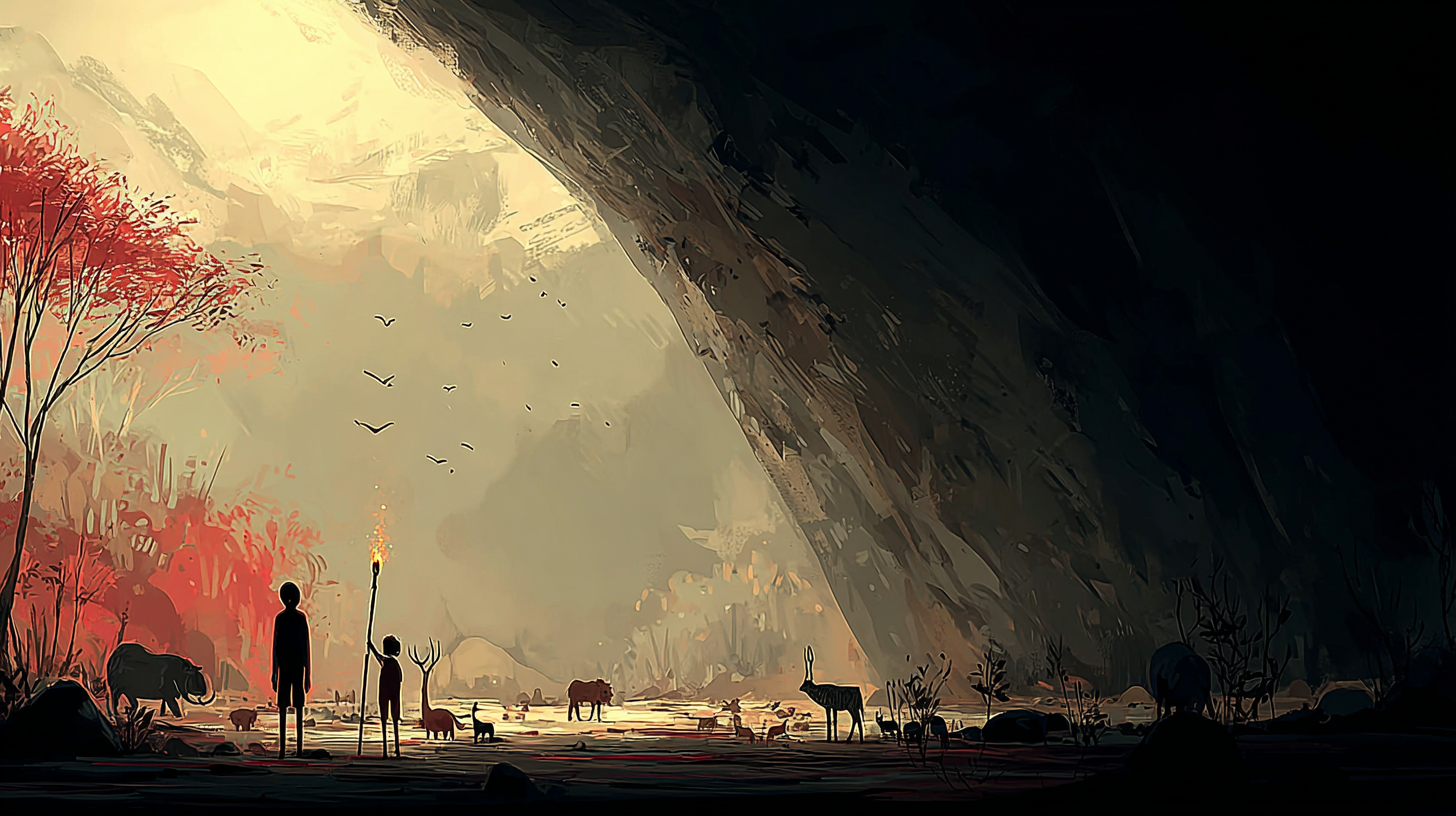“Prehistoric” means “from a time before people wrote things down.”
「prehistoric」は「昔すぎて、まだ文字の記録がない時代のこと」。
以下は英単語 “prehistoric” に関するストーリー型学習コンテンツです。まずは大枠の意味を理解して最後の文章で確認しましょう。
「prehistoric」の主な意味(main meaning)
| 品詞 | 意味 | 発音記号 | 英語例文 |
|---|---|---|---|
| 形容詞 (adj.) | 有史以前の、先史時代の | /ˌpriː.hɪˈstɒr.ɪk/ | The cave was filled with prehistoric paintings of animals. |
「prehistoric」の語源(etymology)
出どころ:ラテン語の「prae-(前の)」+「historic(歴史の)」。
核イメージ:「歴史が始まる前の、記録がない時代」
「prehistoric」の類義語(synonyms)
| 類義語 | 英語例文 |
|---|---|
| ancient | The pyramids in Egypt are ancient structures. |
| primitive | They discovered primitive tools made of stone. |
| early | Early humans lived in small groups. |
| archaic | The museum displayed archaic weapons. |
「prehistoric」の反義語(antonyms)
| 反義語 | 英語例文 |
|---|---|
| modern | Modern technology has changed the way we live. |
| contemporary | Contemporary art can be hard to understand. |
「prehistoric」のコロケーション(collocations)
| コロケーション | 英語例文 |
|---|---|
| prehistoric times | People hunted animals in prehistoric times. |
| prehistoric animals | Dinosaurs are examples of prehistoric animals. |
| prehistoric man | Prehistoric man used fire and simple tools. |
| prehistoric cave | We visited a prehistoric cave in France. |
| prehistoric art | Prehistoric art often shows animals and hunting scenes. |
「prehistoric」の2項表現(binomials)
| 表現 | 英語例文 |
|---|---|
| past and present | The museum shows life in the past and present. |
| old and new | The city blends old and new buildings. |
英語ストーリー(english story)
タイトル:A Journey to a Prehistoric Cave
Last summer, Emily and her class went on a school trip to a museum that had a special exhibition about prehistoric life. The students were excited because they had just finished studying prehistoric times in history class. At the museum, they saw prehistoric animals like mammoths and saber-toothed cats. There was also a life-size model of a prehistoric man, showing how people lived without modern tools.
The guide explained that prehistoric art was found in caves, and one of the best examples was a prehistoric cave in France. The cave was filled with drawings of animals, hunting scenes, and handprints. These were made by primitive people using natural colors from rocks. The guide said these ancient paintings are more than 15,000 years old.
After the tour, Emily said, “It’s amazing how people in early times created art without modern tools.” Her friend Mark added, “It makes me wonder how much we can learn from the past and present together.”
Their teacher explained that understanding old and new ways of life helps us appreciate human progress. Emily thought about how different modern life is compared to the prehistoric world, and how lucky they were to live in a time with technology and safety.
和訳
タイトル:先史時代の洞窟への旅
去年の夏、エミリーとクラスメートたちは、**先史時代(prehistoric)の生活に関する特別展を見に博物館へ行きました。ちょうど歴史の授業で先史時代(prehistoric times)**を学んだばかりだったので、みんな楽しみにしていました。
博物館では、マンモスやサーベルタイガーなどの**先史時代の動物(prehistoric animals)**が展示されていました。さらに、**先史時代の人間(prehistoric man)**の実物大模型もあり、現代の道具がない時代の暮らしを再現していました。
ガイドさんは、**先史時代の美術(prehistoric art)が洞窟で見つかっていることを説明しました。中でも有名なのはフランスの先史時代の洞窟(prehistoric cave)です。その洞窟には動物、狩りの場面、手形などの絵が描かれていました。これらは原始的な(primitive)人々が岩から取った自然の色で描いたそうです。ガイドによると、これらの古代の(ancient)**絵は1万5千年以上前のものです。
見学が終わった後、エミリーは「昔の人が現代の道具なしで芸術を作ったなんてすごい」と言いました。友達のマークは「**過去と現在(past and present)**を比べると、学べることがたくさんあるね」と答えました。
先生は「**古いものと新しいもの(old and new)**の両方を理解することで、人間の進歩が見えてきます」と説明しました。エミリーは、**現代の(modern)生活がどれほど便利か、そして先史時代(prehistoric)**の世界と比べてどれほど違うかを思い、今の時代に生きられることに感謝しました。
「prehistoric」のQ&A
- Q類義語「ancient」と「prehistoric」の違いは何ですか?
- A
「prehistoric」は文字による記録が始まる前の時代を指します。一方「ancient」は非常に昔を表しますが、古代エジプトやローマなど、文字記録がある文明も含みます。
- Q「primitive」は人に対して使っても大丈夫ですか?
- A
「primitive」は「原始的な」という意味で使われますが、人に直接使うと失礼に聞こえることがあります。技術や道具に使うのが一般的です。
- Q「archaic」と「prehistoric」は同じ意味ですか?
- A
「archaic」は古くて今では使われない言葉や制度などに使います。「prehistoric」は歴史が始まる前の時代に使います。似ていますが、使い方が異なります。
- Q「modern」は「prehistoric」の正反対の意味ですか?
- A
はい。「modern(現代の)」は「prehistoric(先史時代の)」の反対語としてよく使われます。時間の流れで一番離れた関係になります。
- Q「contemporary」はなぜ「prehistoric」と反対語なのですか?
- A
「contemporary」は「現代の」「同時代の」という意味で、今の時代を表します。「prehistoric」は記録のない遠い昔のことなので、意味が反対になります。
- Q「prehistoric animals」はどんな動物を指しますか?
- A
恐竜やマンモスなど、記録が残っていない古い時代に生きていた動物のことです。
- Q「prehistoric times」はいつの時代のことを言うのですか?
- A
文字が発明される前、つまり記録がない太古の昔の時代を指します。人類が火や石の道具を使っていた時代です。
- Q「prehistoric art」とは何ですか?
- A
洞窟の壁に描かれた絵など、先史時代に作られた芸術です。動物や狩りの様子が多く描かれています。
- Q「prehistoric cave」はどこで見られますか?
- A
有名なのはフランスのラスコー洞窟やスペインのアルタミラ洞窟などです。壁画が残っています。
- Q「prehistoric man」はどんな人を指しますか?
- A
石の道具を使い、火を使い始めた初期の人類を指します。記録がない時代の人々です。
| 単語 | 意味 | ニュアンスの違い | よく使う場面 | 例文 |
|---|---|---|---|---|
| prehistoric | 先史時代の | 歴史に記録される前の、化石や遺跡でしかわからない時代 | 恐竜、石器時代、考古学 | Dinosaurs lived in prehistoric times.(恐竜は先史時代に生きていた。) |
| ancient | 古代の | 歴史に記録があるとても古い時代 | 古代エジプト、ギリシャ、ローマなど | The pyramids are ancient structures.(ピラミッドは古代の建造物です。) |
| primitive | 原始的な | 技術や文化がとても未発達な状態 | 原始生活、道具、社会 | They used primitive tools.(彼らは原始的な道具を使っていた。) |
| archaic | 古風な・古語の | 今では使われない、古くさい印象 | 言葉、考え方、制度など | That rule is a bit archaic.(そのルールは少し時代遅れだ。) |
| early | 初期の・初めの | 物事や時代の始まりの段階 | 発見、文明、時代の流れ | The early humans used fire.(初期の人類は火を使っていた。) |
| old | 古い | 一番基本的な「昔の」ことを表す | 人、物、家、習慣など | This is an old house.(これは古い家です。) |
覚え方のポイント
- prehistoric → 歴史の「前」、記録のない時代(恐竜など)
- ancient → 歴史に残っているけどとても昔(古代文明)
- primitive → 「技術や文化が未発達」な状態
- archaic → 「古すぎて今は使われない」感覚
- early → 時代や出来事の「始まり」や「初期」
- old → 単に「古い」



コメント